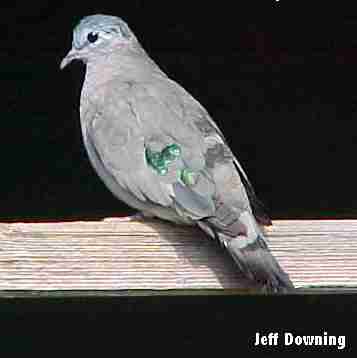
Emerald-spotted Wood Dove
Turtur chalcospilos
AKA: Green-spotted Wood Dove; Emerald-spotted Dove



Female
(Lisa
May)
Male


Lisa May
Distribution: Has the largest distribution of the three spotted wood doves. Inhabits the semi-arid & semi humid woodlands & Acacia savannas throughout eastern Africa from Ethiopia, southeastern Sudan through western Somalia, Kenya, Tanzania, southeastern Zaire, Zambia, Mozambique into eastern South Africa & from northern Botswana westward in a narrow belt to Namibia then north along the coastal area of Angola to Gabon.
Description: (Wagler 1827) Length 20 cm. Whitish forehead shading to bluish grey crown & nape. Hindneck, mantle, scapulars wing shields & upper back a pale greyish brown. The wing shields have two iridescent emerald green patches. The back, mantle is separated from the paler colored rump & uppertail coverts by two blackish bands enclosing a pale whitish fawn area. Neck & breast & chest a mauve pink. Eyes dark brown. Black stripe from front of eye to bill. Bill back having a purplish base (east Africa) or a reddish base (southern Africa). Sexes alike; with female being more pale. Juvenile has barred buff & rust with dark edging of the rust plumage.
Nesting: 2 cream colored eggs, incubation 13-15 days; young fledge 16 to 18 days.

©Wilde Duiven
Emerald-spotted showing melanistic effects of being kept indoors away
from direct sunlight. Many species when kept in sunless conditions attain the
melanistic feathering. Allowing the birds access to direct sunlit areas will
reduce this effect in the next molt.
Voice:
![]() (©Lisa May) very similar to the call of the
Black-billed Wood Dove but shorter in length; a series of 13-15 soft coos
lasting about 15 seconds. Both sexes have similar cooing, the females are
usually a few coos less then the males'.
(©Lisa May) very similar to the call of the
Black-billed Wood Dove but shorter in length; a series of 13-15 soft coos
lasting about 15 seconds. Both sexes have similar cooing, the females are
usually a few coos less then the males'.
Note: it may be possible that this specie may also have a slight visual dimorphism between the sexes as noted in the Black-billed Wood Dove & Blue-spotted Wood Dove.